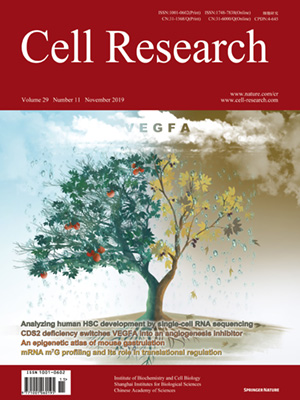
Volume 29, No 11, Nov 2019
ISSN: 1001-0602
EISSN: 1748-7838 2018
impact factor 17.848*
(Clarivate Analytics, 2019)
Volume 29 Issue 11, November 2019: 881-894 | Open Access
ORIGINAL ARTICLES
Tracing the first hematopoietic stem cell generation in human embryo by single-cell RNA sequencing
Yang Zeng1, Jian He2, Zhijie Bai 2, Zongcheng Li 1, Yandong Gong2, Chen Liu2, Yanli Ni1, Junjie Du2, Chunyu Ma3, Lihong Bian3,Yu Lan4 and Bing Liu 1,2,4,5
1State Key Laboratory of Experimental Hematology, Fifth Medical Center of Chinese PLA General Hospital, Beijing 100071, China; 2State Key Laboratory of Proteomics, Academy of Military Medical Sciences, Academy of Military Sciences, Beijing 100071, China;3Department of Gynecology, Fifth Medical Center of Chinese PLA General Hospital, Beijing 100071,China; 4Guangzhou Regenerative Medicine and Health-Guangdong Laboratory (GRMH-GDL); Key Laboratory for Regenerative Medicine of Ministry of Education, Institute of Hematology, Department of Pathophysiology, School of Medicine, Jinan University, Guangzhou 510632, China and 5State Key Laboratory of Experimental Hematology, Institute of Hematology and Blood Diseases Hospital, Chinese Academy of Medical Sciences, Tianjin 300020, China
Correspondence: Yu Lan (rainyblue_1999@126.com) or Bing Liu (bingliu17@yahoo.com)These authors contributed equally: Yang Zeng, Jian He, Zhijie Bai, Zongcheng Li
Tracing the emergence of the first hematopoietic stem cells (HSCs) in human embryos, particularly the scarce and transient precursors thereof, is so far challenging, largely due to the technical limitations and the material rarity. Here, using single-cell RNA sequencing, we constructed the first genome-scale gene expression landscape covering the entire course of endothelial-to-HSC transition during human embryogenesis. The transcriptomically defined HSC-primed hemogenic endothelial cells (HECs) were captured at Carnegie stage (CS) 12–14 in an unbiased way, showing an unambiguous feature of arterial endothelial cells (ECs) with the up-regulation of RUNX1, MYB and ANGPT1. Importantly, subcategorizing CD34+CD45− ECs into a CD44+ population strikingly enriched HECs by over 10-fold. We further mapped the developmental path from arterial ECs via HSC-primed HECs to hematopoietic stem progenitor cells, and revealed a distinct expression pattern of genes that were transiently over-represented upon the hemogenic fate choice of arterial ECs, including EMCN, PROCR and RUNX1T1. We also uncovered another temporally and molecularly distinct intra-embryonic HEC population, which was detected mainly at earlier CS 10 and lacked the arterial feature. Finally, we revealed the cellular components of the putative aortic niche and potential cellular interactions acting on the HSC-primed HECs. The cellular and molecular programs that underlie the generation of the first HSCs from HECs in human embryos, together with the ability to distinguish the HSC-primed HECs from others, will shed light on the strategies for the production of clinically useful HSCs from pluripotent stem cells.
https://doi.org/10.1038/s41422-019-0228-6
FULL TEXT | PDF
Browse 1202


